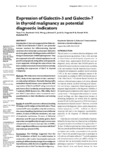| dc.contributor.author | Than, TH | |
| dc.contributor.author | Swethadri, GK | |
| dc.contributor.author | Wong, J | |
| dc.contributor.author | Ahmad, T | |
| dc.contributor.author | Jamil, D | |
| dc.contributor.author | Maganlal, RK | |
| dc.contributor.author | Hamdi, MM | |
| dc.contributor.author | Abdullah, MS | |
| dc.date.accessioned | 2013-06-10T08:11:06Z | |
| dc.date.available | 2013-06-10T08:11:06Z | |
| dc.date.issued | 2008-04 | |
| dc.identifier.citation | Singapore Med J. 2008 Apr;49(4):333-8 | en |
| dc.identifier.uri | http://hinari-gw.who.int/whalecomwww.ncbi.nlm.nih.gov/whalecom0/pubmed/18418527 | |
| dc.identifier.uri | http://erepository.uonbi.ac.ke:8080/xmlui/handle/123456789/30462 | |
| dc.description.abstract | INTRODUCTION:It has been suggested that Galectin-3 (Gal-3) and Galectin-7 (Gal-7) are potential tumour markers for differentiating thyroid carcinoma from its benign counter part. Galectins are beta-galactoside-binding proteins with Gal-3 being a redundant pre-mRNA splicing factor. They are supposed to be p53-related regulators in cell growth and apoptosis, being either anti-apoptotic or pro-apoptotic. Although the value of Gal-3 has been studied extensively, there is little knowledge regarding the expression of Gal-7 in thyroid malignancy.
METHODS:
We initiated an immunohistochemical (IHC) study on the expression of Gal-3 and Gal-7 on various thyroid lesions. Formalin-fixed paraffin embedded thyroid tissues were stained for IHC expression of Gal-3 and Gal-7 using monoclonal anti-human Gal-3 antibody and anti-human Gal-7 antibody (R&D Systems Inc, MN, USA). Gal-3 and Gal-7 expressions were measured semiquantitatively on their distribution and staining intensity.
RESULTS:
A total of 95 cases were collected, including 32 benign and 63 malignant thyroid lesions. These contained 37 cases of papillary thyroid carcinoma, nine cases of papillary thyroid carcinoma follicular variant, 16 cases of follicular carcinoma, one case of anaplastic carcinoma, 14 cases of follicular adenomas and 18 cases of nodular goitre. Gal-3 expression was significantly strong in cancer cases compared to non-cancer cases (p-value is 0.000), while no significant difference was noted with Gal-7 expression (p-value is 0.870).
CONCLUSION:
Our findings suggested that the IHC localisation of Gal-3 is a useful marker in conjunction with routine haematoylin and eosin staining in differentiating benign from malignant thyroid lesions, while there is no significant adjunct diagnostic value in Gal-7 for thyroid malignancy | en |
| dc.language.iso | en | en |
| dc.publisher | University of Nairobi | en |
| dc.title | Expression of Galectin-3 and Galectin-7 in thyroid malignancy as potential diagnostic indicators. | en |
| dc.type | Article | en |
| local.publisher | School of medicine,University of Nairobi | en |
| local.publisher | Department of Paraclinical Sciences, Faculty of Medicine and Health Sciences, Universiti Malaysia Sarawak | en |

